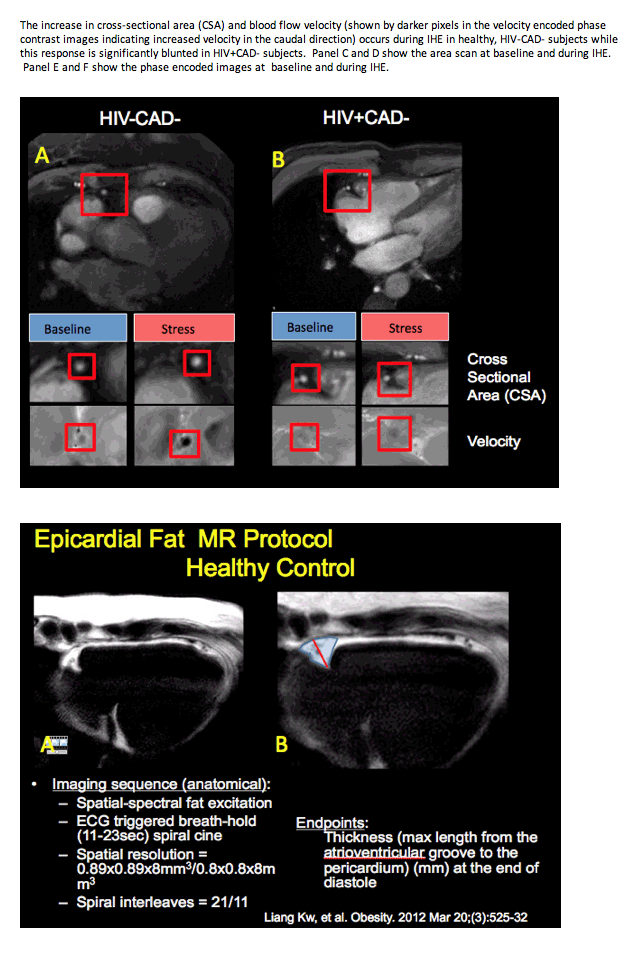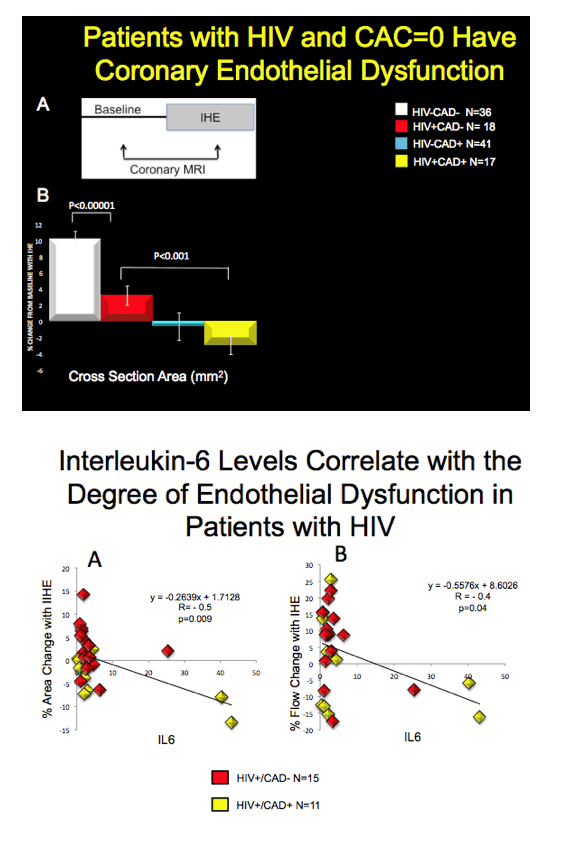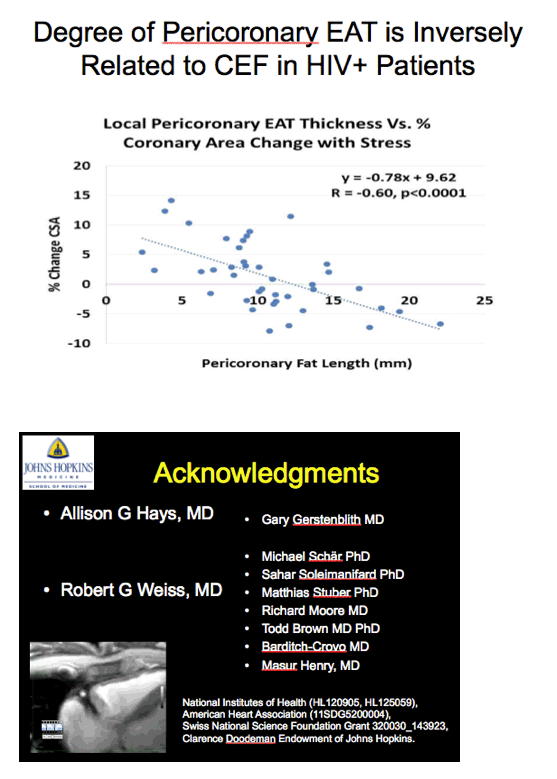 |
 |
 |
| |
Coronary Endothelial Dysfunction is Present in HIV+ Patients Despite a Zero Coronary Artery Calcium Score and is Related to the Degree of Inflammation
and Local Epicardial Fat (heart)
|
| |
| |
Reported by Jules Levin
18th International Workshop on Comorbidities and Adverse Drug Reactions in HIV, September 12-13, 2016, New York
Micaela Iantorno MD, Michael Schar PhD,
Sahar Soleimanifard PhD, Richard Moore MD, Todd Brown MD PhD, Barditch-Crovo MD, Gary Gerstenblith MD, Robert G. Weiss MD and Allison G. Hays MD
[Epicardial fat (EF) is a visceral fat deposit, located between the heart and the pericardium, which shares many of the pathophysiological properties of other visceral fat deposits, It also potentially causes local inflammation and likely has direct effects on coronary atherosclerosis.....The pericardium (from the Greek περι, "around" and καρσιον, "heart") is a double-walled sac containing the heart and the roots of the great vessels.]

Micaela Iantorno MD, Michael Schar PhD,
Sahar Soleimanifard PhD, Richard Moore MD, Todd Brown MD PhD, Barditch-Crovo MD, Gary
Gerstenblith MD, Robert G. Weiss MD and Allison G. Hays MD
Program abstract
Objectives/aim: HIV+ people are now experiencing an increasing burden of chronic diseases (CAD). Although traditional CAD risk factors are more prevalent in HIV, they do not adequately account for the increased risk. Abnormal coronary endothelial function (CEF). predicts future coronary events in the general population and can now be measured non-invasively with magnetic resonance imaging (MRI) to detect changes in coronary artery area (CSA) in response to isometric handgrip exercise (IHE) - an endothelial stressor.Abnormal coronary endothelial function (CEF). predicts future coronary events in the general population. Because chronic inflammation plays an important role in arteriosclerosis pathogenesis in the general population, we also determined whether the degree of impaired CEF in HIV+ subjects is related to the circulating levels of inflammatory biomarkers C-reactive protein (hsCRP) and interleukin-6 (IL6).
Methods: IHE-induced changes in coronary CSA were measured with 3T MRI in 19 HIV+ subjects without CAD (HIV+CAD-), 36 healthy individuals matched for age and CAD risk factors without HIV and without CAD ((HIV--CAD-), 41 subjects with known CAD but no HIV (HIV-CAD+), and 17 HIV+ subjects with CAD (HIV+CAD+). HIV+CAD- subjects had zero Agaston coronary calcium (CAC) score and no computed tomography angiographic evidence of stenosis. HIV-CAD- subjects were subjects under age 50 years with no CAD risk factors or if older than 50 with CAC score <10 or negative exercise stress test. CAD+ subjects had stable CAD on optimal medical management and with luminal stenosis between 30% and 70% on prior coronary X-ray angiography. Data are expressed as mean +/-SEM.
[Steve Grinspoon was moderating session and asked I believe if they included non-calcified high risk plaque when they say "no CAD" - he has reported non-calfied high risk plaque as a subclinical risk factor in HIV+ - and the presenter said yes I think that they include this when they say "no CAD"....http://www.natap.org/2015/CROI/croi_53.htm]
Results: Coronary arteries of healthy HIV-CAD- subjects vasodilator in response to IHE (CSA change from baseline 10.0 +/-0.8%, P<0.0001), as expected, while this vasodilatory response was significantly impaired in HIV+CAD- individuals (CSA change 3.3 +/-0.9%; P<0.0001 versus HIV-CAD-). CEF in HIV+CAD- participants were slightly better than in the HIV-CAD+ subjects (-1.7 +-1.6%, P<0.03). (-1.7 +/-1.6%, P<0.03). HIV+CAD+ subjects vasoconstricted in response to IHE (-2.6 +/-1%; P<0.001) versus HIV+CAD-). Although hsCRP levels did not differ significantly from the four groups, IL6 levels differed among the four groups (P<0.001) with mean IL6 levels significantly higher in HIV+ individuals as compared to HIV- (4.2 +/1.6 versus 1.1 +/- pg/ml (HIV-CAD-), P<0.001, and versus HIV-CAD+ (2.5 +/-0.6 pg/ml, P=0.05). In HIV+ subjects only, IL6 levels were significantly inversely correlated to CEF (R= -, Y= -0.26X+1.7; P=0.009).
Conclusions/discussion:
Marke coronary endothelial dysfunction is present in HIV+ subjects without significant CAD. Furthermore, there is a significant inverse relationship between the extent of endothelial dysfunction and the degree of inflammation as measured by IL6 but not hsCRP. These findings promise to inform future studies of new or more aggressive treatment strategies that target endothelial dysfunction and/or inflammation and may improve cardiac outcomes in HIV+ populations.








|
| |
|
 |
 |
|
|